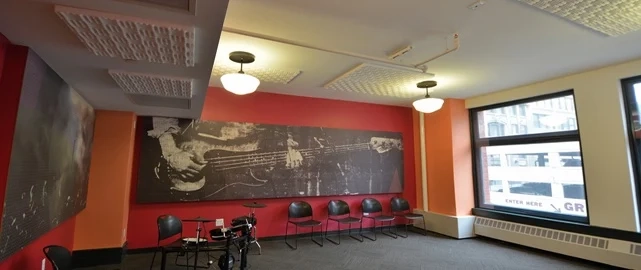

One of the biggest headaches building owners experience is occupant complaints about thermal comfort. In new construction, there is a high level of control over the building envelope and perimeter issues are more easily dealt with. In the renovation of existing and historic structures, there are often additional challenges, particularly where the space is used for either enclosed or open offices at the perimeter. One way to ward off the office grumbles associated with being too cold is by including perimeter radiant heat.
Breakpoint Rule of Thumb
Consider, for example, a building where the heat loss is through the outside wall is calculated based on a wall construction assumed to be a multi-layered clay brick on stone masonry with no insulation and double pane insulating glass (Very typical of a historic mid-rise in Detroit with replacement windows). The “U” value for the wall is 0.29 BTUH/SF/F, while the “U” value for the new glass is 0.53 BTUH/SF/F. The resulting average heat loss for the wall above 300 BTUH/LF. 300 BTUH/LF is the point at which we generally recommend perimeter finned tube radiation for office applications. This is not a hard and fast number, but is based on our collective experience, and is in our opinion good engineering practice. Heat loss through the exterior wall less than 200 BTUH/LF can be effectively handled with overhead airside heating. Heat loss through the exterior wall between 200 BTUH/LF and 300 BTUH/LF can be effectively handled with separate dedicated perimeter overhead airside heating or can be combined to do heating and cooling using linear slot diffuser above the windows
Comfort Issues
The reason we apply perimeter radiation at these conditions is that an unheated outside wall becomes a cold sink and an occupant in close proximity to the wall becomes a radiator. In other words, the occupant’s body begins to radiate their body heat to the cold surface. In many office layouts, occupants are placed very near the windows. The closer to the perimeter the occupant sits, the greater the risk of comfort issues. We can attempt to handle the heat loss strictly by heated air from the air distribution system, but there can be undesirable aspects to this approach as well.
Using airside heating to overcome heat loss may make the space feel drafty when the hot air is blown at the cold exterior. In order to be effective, a sufficient amount of warm air needs to be supplied to offset the heat loss through the wall. If the air is not hot enough you will need to blow a lot of it. If the air is too hot, it will stratify and not effectively offset the heat loss.
As an example, often times, a heat pump system is employed for these type of projects, and heat pumps do not modulate their heat in a variable fashion - it is either on or it is off. This means that at times there will be room temperature air blowing into the space which could easily feel drafty under the right conditions and other times where the heated air can feel too warm, resulting in alternating hot/cold comfort issues from the occupants.
Other Considerations
Perimeter radiant heat will cost roughly $40/Lineal FT to $50/Lineal FT, depending on the style of the finned tube or radiant ceiling panel. This is just the approximate cost of the perimeter heat only, not including the central heating plant. Depending on the exterior exposure, this could impact the $/SFT cost model between $2 to $5/SFT. This investment will be offset by a more comfortable and desirable interior environment and operational savings.
When finned tube radiation is used, air handling equipment can be reset to a lower temperature or turned off and space temperatures are still maintained. This reduces costs as the amount of energy required to push water is less than that required to push air.
Finned tube or other perimeter heating methods are not required by code. It is a comfort-driven consideration and a choice to be made with both budgetary consideration and satisfaction of prospective tenants.
If there is influence on the tenant layout, avoiding placement of offices and workstations directly at the perimeter can help to minimize issues if perimeter radiant heat is not used.
If the building owner chooses to not install finned tube radiation at the time of initial construction, provisions could still be made in heating plant infrastructure to support finned tube in the future if comfort conditions become unacceptable (piping would still need to be routed through the building to the elements).
These Stories on Office